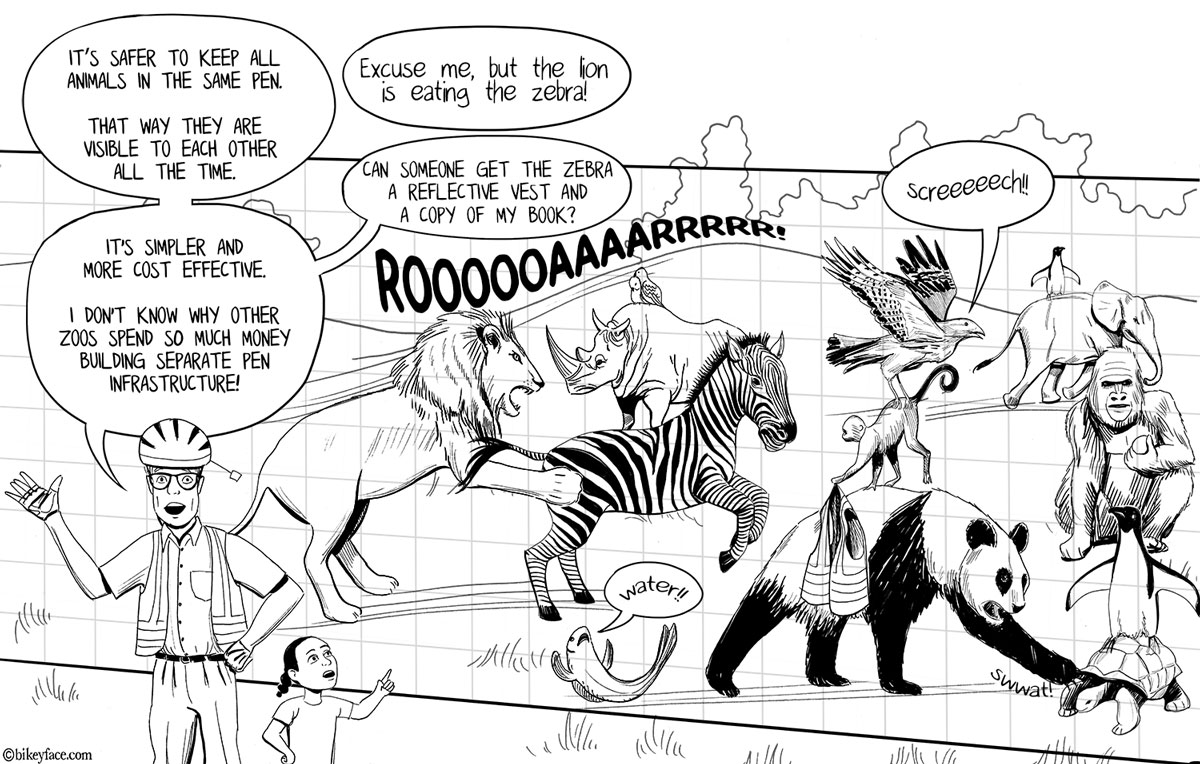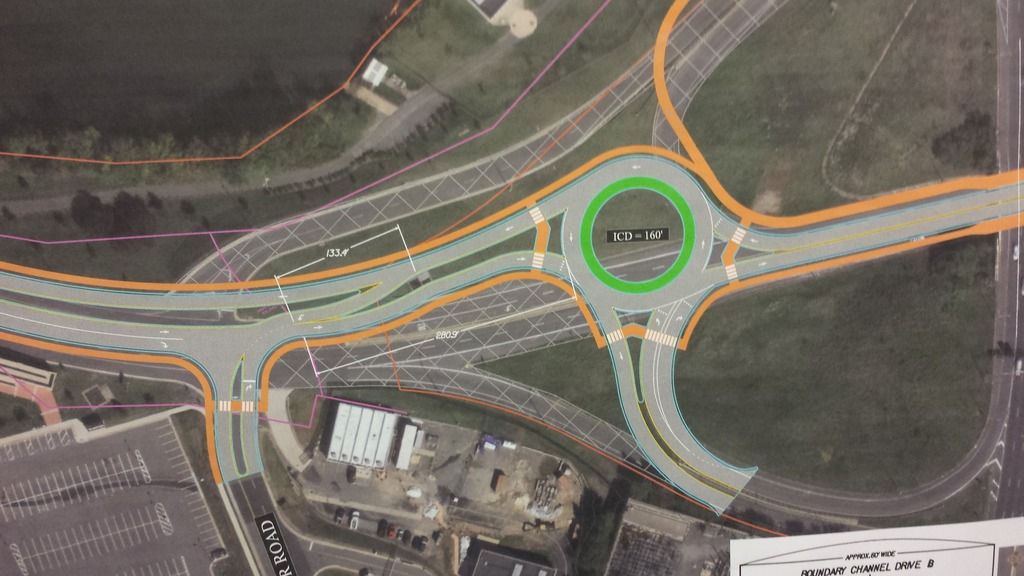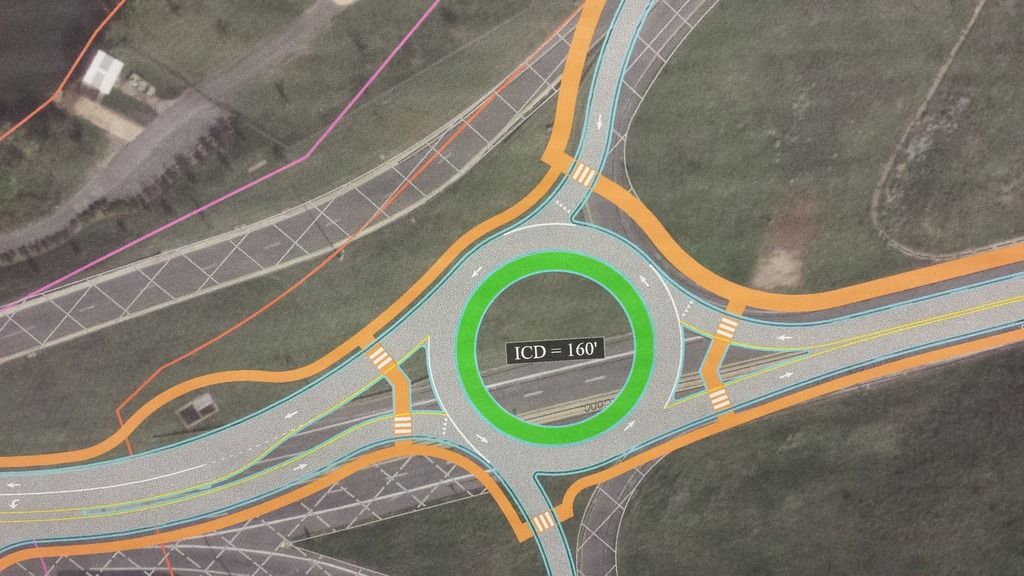Boundary Channel Drive Interchange Project – Public Meeting
Our Community › Forums › General Discussion › Boundary Channel Drive Interchange Project – Public Meeting
- This topic has 52 replies, 17 voices, and was last updated 8 years, 9 months ago by
paulg.
-
CreatorTopic
-
June 10, 2015 at 10:19 pm #916953
Bike-Ped Manager
ParticipantArlington is hosting a public information meeting on Tuesday, June 23 at 6:30 p.m. at the Aurora Hills Community Center for the project to replace and improve the interchange of Boundary Channel Drive, Interstate 395 and Long Bridge Drive. The meeting flyer is attached.
All members of the Arlington community are invited to attend and provide input on interchange design alternatives. Can’t attend? Potential interchange concepts will be posted on the project webpage in advance of the meeting.
For more information, please contact:
Bonnie A. Parker
Community Strategy Consultant
Division of Transportation
Arlington County Department of Environmental Services
703-228-3173 direct -
CreatorTopic
-
AuthorReplies
-
June 24, 2015 at 7:11 pm #1032890
mstone
Participant@DismalScientist 118899 wrote:
Putting segregated facilities on both sides of the underpass has the effect of narrowing the lanes under the underpass, potentially to the point where cars can no longer make safe passes of cyclists in the road.
The cars might have to not pass cyclists at that particular spot! Oh the huge manatee!
June 24, 2015 at 9:32 pm #1032902scoot
Participant@Steve O 118924 wrote:
And non-segregated facilities already suggest to most people that they shouldn’t be riding a bicycle.
But it’s not the facilities per se that they’re afraid of, it’s bad drivers. Why do we accept these little safe-haven band-aids all over the place as a substitute for addressing the real problem?
The analogy in that cartoon is utter nonsense. I’ll have to remember that the next time my car is low on fuel: run down a cyclist so I can fill my tank with his organic matter… :rolleyes:
June 24, 2015 at 11:00 pm #1032904DismalScientist
Participant@Steve O 118924 wrote:
And non-segregated facilities already suggest to most people that they shouldn’t be riding a bicycle.
I’m sure the street in front of your house scares the hell out of the newbs.
It would be more efficient to have some minimum traffic count before deciding to implement some non-trivial bike facilities.
June 24, 2015 at 11:10 pm #1032905DismalScientist
Participant@DaveK 118901 wrote:

So we need separate facilities for cars, for bikes, for pedestrians, for rollerbladers, for joggers, for e-bikes, for segways… Eventually I see issues with so much land devoted to transportation.
One key question here should be whether it is better to mix bicycles with pedestrians or cars. And why do you need 14 foot sidepaths on both sides of the underpass? I would make the eastern one wide , the western one narrow, and give the extra space to the roadway.
Narrow arterials the don’t allow easy passing of cyclists, with or without sidepaths, is one reason it sucks to ride in Fairfax and the other outer counties.
June 24, 2015 at 11:27 pm #1032907 lordofthemarkParticipant
lordofthemarkParticipantThe worst part of riding in Fairfax are A . narrow arterials which do not even have side paths as an option B.narrow arterials with sidepaths, where the side path is hidden behind cars and has multiple driveways creating problems that will not exist here, plus the sidewalks are narrow, poorly paved, and with lots of obstacles. Just as not all roads are equal, not all side paths are zero.
Whe there bikes should mix with cars or pedestrians will depend on volume and speed of traffic, as you point out, but also the speed of the cyclist, and their willingness to act as a pedestrian at intersections and ramp crossings. In this case both are accommadated. While someone riding in the general travel lane may prefer a wide lane for passing, I think the whole length on Boundary Channel is short enough that will be less of a problem than going miles like that in Fairfax. Plus, IIRC it is flat – the worst places in Fairfax are uphills.
June 25, 2015 at 12:34 am #1032910mstone
Participant@DismalScientist 118940 wrote:
Narrow arterials the don’t allow easy passing of cyclists, with or without sidepaths, is one reason it sucks to ride in Fairfax and the other outer counties.
I actually find it much worse to ride on the roads where they do the “wide outer lane” nonsense. The cars then try to do a too-close in-lane pass way over the speed limit. I’m much happier on the roads that haven’t been improved yet where I can control the lane. They can pass when it’s safe.
June 25, 2015 at 1:02 am #1032911dbb
ParticipantHere are some closeups of the roundabouts on the Pentagon side of the interstate. The Columbia Island lagoon in in the upper left of each image and you can see one or both of the small buildings the Pentagon has on the lagoon.
Each concept shows roadways that will be removed as cross hatched.
In this concept there are no road crossings on the riverside trail as the existing 395 (southbound) offramp would be removed. A suggestion was made to add a third leg of the trail at the top of the roundabout so a cyclist could more easily continue to the north (upstream).
In this concept, all the ramps on the river side of the roundabout would be removed.
In concept 2, the the riverside trail would have to cross an off ramp from 395 southbound as well as the on ramp to 395 southbound. That double crosswalk is potentially problematic as the off ramp is a the bottom of the hill (which would tend to increase the vehicle speed) and the geometry at the entrance and logical exit to the roundabout would be along a line which is largely straight. This would permit autos leaving 395 south to pass through the roundabout with little (no?) need to slow. This differs with the riverside trail where a cyclist would have a sharp turn on the interstate side of the on/off ramp and a turn between the ramps. These would tend to moderate the speed of the cyclists (as opposed to the comparatively unimpaired routes for the motorists).
This concept has only one ramp on the river side of the roundabout but the potential for speeding through the roundabout might actually be greater in this concept.
The roadway/paths on Boundary Channel will likely have the greatest bike traffic on the river side. It would seem logical that using the total width of the complete roadway that we might provide the two traffic lanes with the same width as proposed but have a protected bike lane and a sidewalk on the river side and a wide sidewalk (but not 14 feet) on the other side.
June 25, 2015 at 1:13 am #1032912DismalScientist
ParticipantI don’t think this is a particular issue at this location.
I also think that cyclist controling the lane when they don’t need to also leads to resentment. As a driver, I certainly get frustrated when fellow drivers needlessly impede traffic. Personally, I have rarely experienced drivers buzzing me in wide lane situations. In general, I’ll ride 3 feet from the pavement edge, not necessarily the fog line. I’ll ride farther out the faster I’m going. I would hope that drivers don’t view double yellow lines as sacroscant and pass appropriately when sight lines are good. Perhaps I was spoiled growing up in Wisconsin where we had paved shoulder and good sightlines on lightly travelled country roads.
June 25, 2015 at 1:56 pm #1032925 lordofthemarkParticipant
lordofthemarkParticipantNeed for traffic separation depends on relative speed – the ebikes, roller bladers, etc, can fit in our infra depending on the speeds they can and do maintain. It is quite possible to have pedestrians and autos sharing a space when auto speeds are sufficiently limited – the Dutch call that a woonerf, and it is commonly encountered in the US in parking lots, and sometimes in more overtly Dutch style on private property, as at the Penrose complex in Arlington. IIUC City of Alexandria contemplated it for the foot of King Street, but wimped out. The disagreements about when bikes belong on the road or in seg infra are about our views of where the right speed cutoff for sharing is (and to some extent our assumptions about the importance of accommodating slower cyclists, and cyclists who are too cautious relative to their own ability)
The debate between Dismal and MStone above is actually about two different philosophies of road sharing – building wide lanes that allow room for drivers to pass in lane with 3 foot clearance, at the expense of probably higher auto speeds, versus narrower lanes that require cyclists taking the road to lock the lane. The debate is likely to center on beliefs about driver behavior – under what circumstances drivers will cross the yellow line to pass, when they will pass to close, and what the psychological effects of them being stuck behind a cyclist for any length of time will be. My own sense is that drivers in this regions are very heterogeneous on those traits, which makes consensus difficult.
June 25, 2015 at 2:26 pm #1032934mstone
Participant@lordofthemark 118963 wrote:
The debate between Dismal and MStone above is actually about two different philosophies of road sharing – building wide lanes that allow room for drivers to pass in lane with 3 foot clearance, at the expense of probably higher auto speeds, versus narrower lanes that require cyclists taking the road to lock the lane. The debate is likely to center on beliefs about driver behavior – under what circumstances drivers will cross the yellow line to pass, when they will pass to close, and what the psychological effects of them being stuck behind a cyclist for any length of time will be. My own sense is that drivers in this regions are very heterogeneous on those traits, which makes consensus difficult.
Pretty much. In general, my opinion is that if there’s enough room for VDOT to put in their typical oversize lane plus a supersize lane, there’s enough room for two narrower (lower top speed) lanes and a real bike lane. If there isn’t really that much room, WTH do I want to get buzzed by speeding cars that are passing too close in the lane? What this is really about is that VDOT doesn’t want to narrow lanes because it makes it harder for people to speed and speeding makes their LOS numbers better because the LOS metric doesn’t care about anything but how long cars have to wait for anything.
June 25, 2015 at 2:34 pm #1032937 lordofthemarkParticipant
lordofthemarkParticipantOn another topic – I like concept 1, but would add a tiny little connection from the side trail at the top of the roundabout to the trail connecting to the MVT – that would make it easier for not only cyclists coming from the north side of the Pentagon to get to the MVT, but for those coming from the bus bays, by allowing them to go take the crosswalk before the roundabout, without having to make a 270 degree left turn to get on the trail to the MVT. I used to go from the bus bays to the MVT when I lived in Annandale, and I know several people (including Mickey of our board) do that regularly.
In the absence of such a connection, I predict a desire path will be created.
June 25, 2015 at 2:51 pm #1032938DaveK
ParticipantI am getting dangerously close to contributing something useful here, but I should point out that sharing the lane side-by-side between cyclists and drivers through a roundabout is extremely dangerous and discouraged in both engineering design and city cycling instruction.
June 25, 2015 at 2:55 pm #1032939 lordofthemarkParticipant
lordofthemarkParticipant@DaveK 118976 wrote:
I am getting dangerously close to contributing something useful here, but I should point out that sharing the lane side-by-side between cyclists and drivers through a roundabout is extremely dangerous and discouraged in both engineering design and city cycling instruction.
I do that every commute at 30th and Columbus in Fairlington – fortunately there is very little traffic, but what IS the correct way to do that – ride in the middle of the lane, or to the right edge of the roundabout?
June 25, 2015 at 3:06 pm #1032941dbb
Participant@lordofthemark 118975 wrote:
On another topic – I like concept 1, but would add a tiny little connection from the side trail at the top of the roundabout to the trail connecting to the MVT – that would make it easier for not only cyclists coming from the north side of the Pentagon to get to the MVT, but for those coming from the bus bays, by allowing them to go take the crosswalk before the roundabout, without having to make a 270 degree left turn to get on the trail to the MVT. I used to go from the bus bays to the MVT when I lived in Annandale, and I know several people (including Mickey of our board) do that regularly.
In the absence of such a connection, I predict a desire path will be created.
That was discussed with the designer that was standing by this panel and he indicated that third leg of the triangle was likely an oversight and was indeed necessary. I showed him my post-it comment to make sure we agreed on the comment.
June 25, 2015 at 3:15 pm #1032943scoot
Participant@lordofthemark 118977 wrote:
I do that every commute at 30th and Columbus in Fairlington – fortunately there is very little traffic, but what IS the correct way to do that – ride in the middle of the lane, or to the right edge of the roundabout?
DaveK brings up an excellent point about roundabouts.
I used to live near the roundabout in front of Fairlington Community Center (at 34th and Stafford). I always use the center of the vehicle lane there. When I use to hedge and stay right to accommodate a car, close calls were inevitable, b/c I couldn’t predict which exit the driver would take. I also avoid the bike lane at Thomas Circle, taking the right auto lane instead from 14th to M.
Both of these are examples of very poor design that goads cyclists into riding in the least safe place on the road.
These Boundary Channel roundabouts should be a single lane, and road-sharing should be accomplished with temporal, not lateral spatial offsets!
-
AuthorReplies
- You must be logged in to reply to this topic.


